|
|
 Director's Letter Director's Letter
 | |
One of the main lessons that has been driven home to me in all this talk about the DIA, its collection, and city bankruptcy is that a little knowledge is a dangerous thing. According to a couple of bloggers, the DIA has not just one work of art by Rembrandt but sixty-four, a statistic that led one of them to put our collection's value at an absurd $15 billion. In fact, we have one undisputed painting, the fabulous Visitation; one painting, Weeping Woman, that most experts now think is by the master but which was, for many years, dismissed as a copy; and one painting, Head of Jesus, "attributed to Rembrandt" (which, I must say, looked pretty good alongside the other head of Jesus studies in our exhibition a few years ago). The rest (seventy-one actually) are prints that vary enormously in quality but, for the most part, are highly questionable. You can see the half dozen or so good impressions in our collection one at a time as they rotate through the Rembrandt room in the Dutch galleries.
Partly because his wife's considerable estate reverted to her family on her death, but mainly because of his own extravagance, Rembrandt declared bankruptcy in 1656 and over the next two years everything that was not necessary for him to pursue his profession was sold. This included his etching plates, which, well into the twentieth century, were passed on from one owner to the next, each using them to create new impressions. When Rembrandt's original etched lines inevitably wore down, new lines were drawn. Most of our prints fall into this category and are just about worthless. When, in 2000, using funds from a donor, we acquired a superb version of the 1634 etching The Angel Appearing to the Shepherds, the dealer we were working with actually said that the impression of the same print, which we had suggested as a possible part exchange, was just that: worthless.
How the DIA came to have so many apparently useless impressions is part of the history of the development of art museums in the United States. Fifty-two prints were given in 1909 by James Scripps, the DIA's first major patron. (In 1889, Scripps gave eighty paintings that formed the foundation of our exceptional collection of European art.) U.S. art museums at the time were more concerned about getting particular images than autograph masterpieces. When it was suggested to the Minneapolis collector T. B. Walker that his Rembrandt painting may not actually be a Rembrandt, his response was basically that it didn't matter, "It's close enough," he said. Scripps was a little more discriminating than that, but the aim then was to bring in representative works for the general public as quickly as possible. The relentless pursuit of masterpieces fell to the next generation, an exemplar of which is Scripps's son-in-law, Ralph Harmon Booth, a true connoisseur who was instrumental in bringing the art historian William Valentiner to Detroit in 1921 and who, in the following decade, played a leading role in building the DIA's collection into one of this country's greatest.

Graham W. J. Beal
Back to top |
|
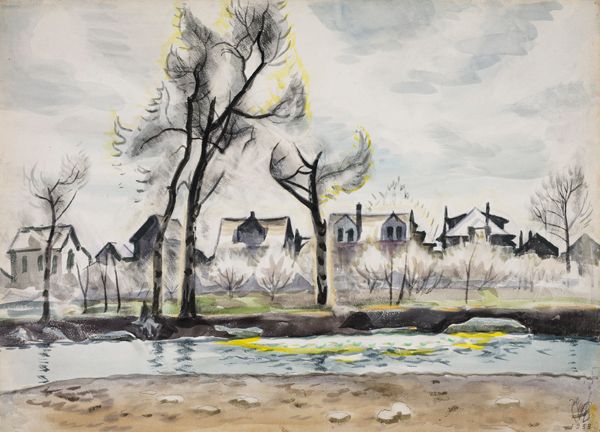
Exhibitions
 Let Me Show You What I Saw: American Views on City and Country, 1912-1963 Let Me Show You What I Saw: American Views on City and Country, 1912-1963
Schwartz Galleries
Through June 29
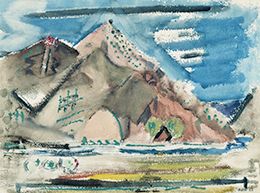 | | |
New Mexican Landscape near Taos, 1930, watercolor and charcoal over graphite pencil on paper; John Marin, American, 1870-1953. Bequest of Robert H. Tannahill
| |
In 2009, the DIA was given four watercolors and one drawing by Charles Burchfield, all visionary landscapes that served as the inspiration for this exhibition. He, like thirty other artists featured, plied his trade during the decades when American art transitioned from its realistic tendencies into abstraction.
Burchfield attempted to make his scenes express information beyond what could be seen, using a code of mark making that makes one feel as if the landscape can also be heard--the crunch of winter snow in Peace at Christmas, the explosive nighttime growth of the forest in Starlit Woods, and the flow of a thawing river in Mid-April Landscape. The Study for Flame of Spring (a full-color painting in the collection of the Cleveland Museum of Art) is just one example of what were often dozens of sketches that led to a final composition.
Martin Lewis's enigmatic renderings of city scenes, such as Shadow Magic and Quarter of Nine, Saturday's Children, serve as a counterpoint to Burchfield's rural vistas. John Marin brought to life the dynamism in both the country and city, as can be seen in the colorful New Mexican Landscape Near Taos and Woolworth Building.
At top: Mid-April Landscape, 1933, watercolor, graphite, and/or charcoal on paper; Charles Ephraim Burchfield, American, 1893-1967. Gift of Christine and George Strumbos
This exhibition, organized by the Detroit Institute of Arts, is free with museum admission.
Back to top
 Foto Europa, 1850 to the Present Foto Europa, 1850 to the Present
Albert and Peggy de Salle Gallery of Photography
Through April 27
 | | |
PJ and Goats, Detroit, 2011, pigment print; Corine Vermeulen, Dutch, born 1977. Museum Purchase, DeRoy Photographic Acquisition Endowment Fund
| |
European photographers have been long interested in their continent's living cities and the remains of its past civilizations. This fascination extends to the contemporary moment and to sites in the United States, including Detroit. The rise of urban exploration and photography of Detroit's abandoned buildings and neighborhoods have dominated photo-sharing sites on the Internet. The proliferation of this imagery and widespread media attention on Detroit's economic decline and depopulation has sparked the attention of young Europeans.
The works in the exhibition by four European photographers show various responses to present-day Detroit, each informed by a personal vision of the city . As some photographers have reveled in ruins, others have found inspiration in the vital parts of Detroit and its resilient citizens.
Yves Marchand and Romain Meffre shared interest in exploring old and out-of-use Parisian theaters. They eventually collaborated on a photography project, traveling frequently to Detroit from 2005 and 2009. Foto Europa includes their photograph of the historic Eastown Theater that opened in Detroit in 1931 and hosted movies and rock music performances more than sixty years.
Upon her many visits to Detroit, German photographer Karin Jobst found the city occupied, not abandoned, and filled with interesting and well-maintained architecture. Experimenting with light, color, and scale, she photographed the city's historic buildings and created an archive of over 800 images that map architectural styles and historical eras.
Dutch-born photographer-turned-Detroiter Corine Vermeulen sees the city as a challenging but inspirational place where community response to social needs have given rise to alternative forms of urban life. Her photographic work includes many portraits of Detroit citizens, including one of her neighbor PJ feeding two young goats from a local school and urban farm.
This exhibition, organized by the Detroit Institute of Arts, is free with museum admission.
Back to top
 Balance of Power: A Throne for an African Prince Balance of Power: A Throne for an African Prince
Walter Gibbs Gallery, Wayne and Joan Webber Education Wing
Through March 16
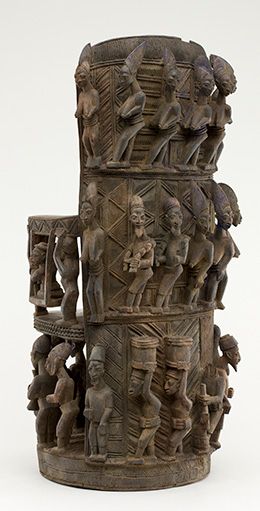 | | |
Chief's Throne, wood, pigments; Olówè of Isè, Yoruba, Nigeria; early 20th century. Museum Purchase, Ernest and Rosemarie Kanzler Foundation Fund, and with funds from Robert B. Jacobs
| |
Little is known of the early life and artistic training of renowned African sculptor Olówè of Isè. He was born in about 1870 and garnered a reputation as a sculptor for kings among his native Yoruba people. According to Yoruba oral history, he could sculpt a person's likeness on the spot--without looking at the wood he was carving. This throne was carved from a single tree trunk.
The composition of the throne's rich decoration reflects Olówè's unique style of carving in such high relief that the figures appear three-dimensional, about to step off the highly textured background filled with a profusion of linear designs. Similar qualities can be found on the artist's palace door and ceremonial bowl, also in the DIA collection and on view in the African galleries.
This exhibition is organized by the Detroit Institute of Arts. Support has been provided by the Walter Gibbs Endowment Fund.
Back to top |
|
 New On View New On View
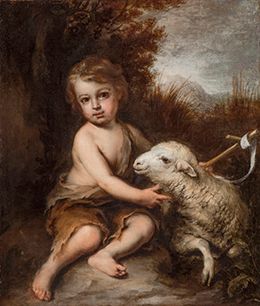 | |
Infant Saint John the Baptist in the Wilderness, ca. 1655-70, oil on canvas; Bartolomé Esteban Murillo, Spanish, 1617-82. Meadow Brook Hall, Oakland University, Rochester, Mich.
| |
A chance visit to Oakland University's Meadow Brook Hall by DIA curator Salvador Salort-Pons led to the discovery of a significant work by the seventeenth-century Spanish artist Bartolomé Esteban Murillo, now on view in the museum's European galleries. Salort-Pons spotted The Infant Saint John the Baptist in the Wilderness, one of the first Murillo paintings to enter a U.S. collection,hanging in a dark corner. In need of conservation, the oil painting came to the DIA through an agreement with Oakland University allowing undergraduate art history and studio art students to observe the technical and scientific analysis performed by museum specialists. In exchange, the painting is on loan to the museum for the next five years.
"Murillo is considered one of the five pillars of Spanish Golden age art. He produced this sentimental masterpiece with his characteristic delicate and loose brushstrokes when he was at the height of his powers," said Salort-Pons.
The Saint John painting belonged, in the 1600s, to the Italian merchant Giovanni Bielato, who donated it to Capuchin Convent of Genova. During the 1800s, it was sold to the family of the Duke of Westminster in London and, in 1926, entered the collection of Alfred G. Wilson, who kept the piece at Meadow Brook Hall. This Murillo was exhibited in the Royal Academy in London in 1883, and this will be the first time it will go on view in a U.S. museum
The DIA owns two other paintings by Murillo, The Flight into Egypt and the Immaculate Conception, which will be displayed together with Meadow Brook's The Infant Saint John in the museum's main European Paintings gallery beginning February 6.
Back to top |
|
 Detroit Film Theatre Detroit Film Theatre
According to the New York Times, now that Hollywood packages Academy Award® nominated short films for theatrical release, they are attracting a growing audience. But DFT regulars have known for years that the Oscar® shorts are traditionally among the year's most creative and surprising films of any kind, making the annual shorts program a perennial favorite.
To accommodate the ever-increasing demand for tickets, the DFT has scheduled a record number of showings of the nominated films in both the animation and live-action categories, separated by a brief intermission. In addition, two screenings of the five nominees in the short documentary category are on the schedule. See them all so you can make your predictions of the winners before the Oscars are handed out on March 2.
This year's animation shorts include Mr. Hublot, a film from Luxembourg in which an eccentric character finds his world disrupted by the arrival of a robot, and Possessions (left), from Japan, featuring a man who finds household objects inhabited by spirits, as well as Get a Horse!, a miniature evocation of the history of Disney animation, that marks Mickey Mouse's first new big-screen appearance in years.
In the live-action category, Britain's The Voorman Problem, tells of a prison psychiatrist who must examine a most unusual inmate; Helium, a moving Danish film about a hospital's eccentric janitor and his friendship with a young patient; and Do I Have to Think of Everything?, a Finnish comedy about a woman whose family may be late for a wedding because she overslept.
Subjects portrayed in the nonfiction category include Ra Paulette, a sculptor who digs massive, cathedral-like caves into sandstone cliffs; a gay victim of a hate crime who meets his attacker twenty-five years later; and a remarkable portrait of Change Square, in Yemen's capital city of Sana'a, where members of a heavily armed population do not see the consequences of putting down their arms to peacefully demand change.
Even with the additional showings, advance tickets are highly recommended. Tickets are available at the DIA Ticket Office, 313.833.4005, or may be purchased online.
For a complete 2014 schedule, click here.
The DFT is presented by Buddy's Pizza.

Back to top |
|
 Congratulations Bill Rauhauser Congratulations Bill Rauhauser
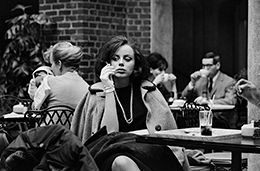 | | |
Kresge Court, Detroit Institute of Arts, ca. 1960s (printed 2012), pigment print; Bill Rauhauser, American, born 1918. Gift of the artist in memory of Doris Rauhauser
| |
We offer hearty congratulations to Bill Rauhauser, photographer, teacher, and long-time friend of the DIA, on his selection as the Kresge Founation's 2014 Eminent Artist. Rauhauser, 95, taught photography at Detroit's College for Creative Studies for thirty-four years, curated exhibitions at the DIA, and had his work shown in Detroit and elsewhere. Many of his pictures catch ordinary people in ordinary situations.
Nancy Barr, DIA curator of photography and one of Rauhauser's former students, told the Detroit News that she was extremely happy "Kresge's honoring Bill. He's influenced generations of Detroit photographers," adding that he has "given us this photographic time machine to step into--a time machine enhanced by his own vision of Detroit that's often comical, always humanistic, and sometimes close to heartbreaking."
Rauhauser's work was most recently seen in the DIA exhibition Motor City Muse, and he served as curator for the 1996 exhibition The Car and the Camera: The Detroit School of Automotive Photography and contributed an essay to the show's catalogue.
Previous Eminent Artists have included Michigan Opera Theatre founder David DiChiera and Detroit artist Charles McGee.
Back to top |
|
 For FebruaryY For FebruaryY
Black History Month
February is Black History Month, and the DIA has relevant programs scheduled each weekend. Performances include Wendell Harrison in a tribute to Detroit's many musical styles and veteran jazz vocalist Naima Shambourger salutes legends Sarah Vaughan, Miles Davis, and Dexter Gordon. There are two Sunday afternoons of storytelling, two movies A Band Called Death and Sidewalk Stories; and a lecture by renowned scholar Sharon Patton on the art of Romare Bearden.
For a complete list of activities, click here. Programs, with the exception of the films, are free with museum admission.
Be My Valentine
Celebrate Valentine's Day at the DIA. The Motown Legends Choir delivers two special concerts of love songs from some of the great Motown groups, including the Contours, the Original Vandellas, and Enchantment. The choir features Mark Scot, the current singer for the Miracles, and jazz/blues singer Joan Belgrave. Concerts are Friday, February 14, at 7 and 8:30 p.m.
And surprise your loved ones with a special Valentine's Day gift from the DIA Museum Shop. From paperweights to mugs, pendants to books, you are sure to find something your sweetheart will cherish.
Back to top |
|
|
|
|
|
Detroit Institute of Arts
5200 Woodward Avenue
Detroit, Michigan 48202
www.dia.org
313.833.7900
Comments or questions about the newsletter? Please contact us: comments@dia.org
ADMISSION
$8 adults, $6 seniors, $4 children
The museum is free for members and residents of Wayne, Oakland, and Macomb Counties
Contact the Membership HelpLine at
313.833.7971 or membership@dia.org
For group sales (15 or more) contact 313.833.1292 or dia.org/grouptours
|
HOURS
Museum
Mon CLOSED
Tue, Wed, Thur 9 a.m.-4 p.m.
Fri 9 a.m.-10 p.m.
Sat, Sun 10 a.m.-5 p.m.
PARKING
Valet parking is $10 per car and available at the Woodward entrance Friday through Sunday during museum hours.
Lighted, secure self-parking is available in the Cultural Center parking lot, between John R and Brush, behind the museum.
|
CaféDIA
313.833.7966
Tue, Wed, Thur 11:30 a.m.-2:30 p.m.
Fri 11 a.m.-2:30 p.m., 4-9 p.m.
Sat, Sun 11 a.m.-3 p.m.
Kresge Court
Tue, Wed, Thur 9 a.m.-3:30 p.m.
Fri 9 a.m.-9:30 p.m.
Sat., Sun 10 a.m.-4:30 p.m.
Museum Shop
313.833.7944 or museumshop@dia.org
Open during museum hours or online at diashop.org
|
|
|
|
|
|

















